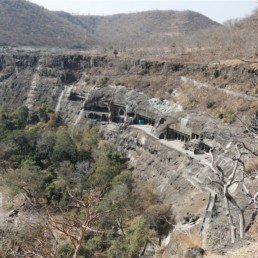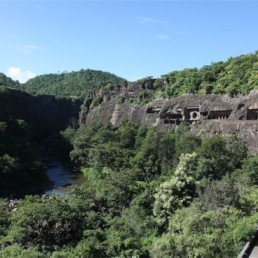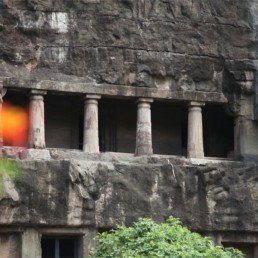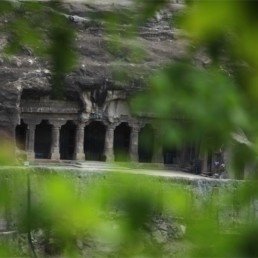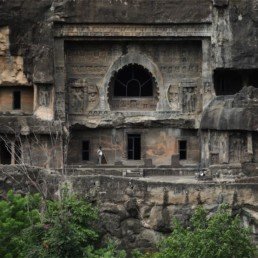RESEARCH
STORY-JOURNEY-TEXT-WORK-VISUAL DOCUMENTATION
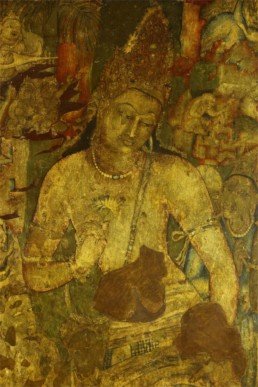
© 2025 prasadpawar. All rights reserved
INSPIRATION
“Ajanta” is a World Heritage Site declared by “Unesco World Heritage Site ” During British era, in 1819, Ajanta was discovered. It is in the shape of “Horse Shoes”, where in God has showered the beauty of nature and we can feel it. It also adds the purity of river Waghur and its seven ponds. This holy and quiet place was surely been attraction for Buddhist Monks for their stay during monsoon. These caves are carved from a stone of around 76 meter tall. These caves are a live and precious depository of Indian Culture. This place is 104 km away from city of Aurangabad in the State of Maharashtra, India. Ajanta caves are made during 2nd to 6th century B.C. in two different times. There are 30 caves in the Ajanta area on the bank of Waghur river, from which in the caves 1, 2, 16 and 17 various paintings are painted on walls, roofs and pillars Jatak Tales of Lord Buddha are painted on the wall, in the rest of the sites flowers, geometrical designs and many others have been created from the mountain rock of Ajanta. The rocks have been carved according to the stone designs and were produced in different sizes. In the caves 1, 2, 16 and 17 the lenses of Lord Buddha’s people (The story of the birth) can be seen. During 1989, I was undergoing studies in the college of art. The famous painting of Ajanta – “The Padmapani” was the subject for studies. A large part of the painting has disappeared due to erosion from time to time. We are desperate to survey the deterioration of Ajanta paintings which are going to be destroyed. What can I do for Ajanta? These thoughts became numb. In fact, painting is a strong media of communication. But these painting have downplayed me and then I realized if this deterioration continues, what would be left for the future generations? What Ajanta they would see in the days to come?

© 2025 prasadpawar. All rights reserved
START OF THE MISSION
From 1989, the mission of Restoration of Ajanta started. Activities planned and the efforts in this direction started. Till the year 2009, I spent my precious time in research and frequent visits to Ajanta because I had to wait for years to obtain permission from Archeological Survey of India. It was the real beginning of the ambitious project “Ajanta Education, Research and Restoration”. It has been easy to work on the mission because I have been God gifted with intelligence, accurate decision power, power to analyze, exact decision ability, unmatched physical ability, teamwork, technical assessment etc. And this reflected in the best performance of my own work. For photographing Ajanta, taking photos with the help of camera is hardly 1% activity but 99% activities are to understand history, relevant information, knowledge, experiences, proper analysis, paintings, sculptures, Indian traditional culture and history of Lord Buddha and the historical evidences of Buddha’s birth. I then realized that a person who is aware about Ajanta and who has that intuition can only work best on the project. The photography work was decided to start from Cave No. 1. The permission was granted to perform photography without disturbing the tourists visiting the place and not to use any halogen lights or flash lights during photography. With these restrictions the challenging work started. A lot of experiments were conducted during the exercise because the walls, roofs and pillars are painted with their best abilities. A specialty in Ajanta paintings is that the Jatak Katha of Bhagawan Buddha are painted in different pieces nearby and it was a very difficult task to study, understand and then organize all these stories in a sequence for photography. After all the photography started and The Department of Archeology offered a set of books and information available with them on “Ajanta”. They advised me to kindly refer the information provided by them. But I clearly refused. Because, the author has produced a book from the history of its context, thinking, visualization, understanding, principles, combined experience and this may dilute my way of thinking and research on the subject. Different authors have seen the painting but they have their own perception and imagination on it and has been written accordingly.
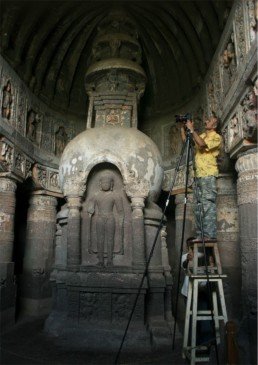
© 2025 prasadpawar. All rights reserved
PRACTICAL THINKING
I am basically an artist and a sculptor, a photographer, a visual creator, an engineer and research fellow with attitude of practical thinking. What I expect from the painting to bring it in the practice is that the best out of the has been usually imagined in my mind and then I can put the best visualized scene and then draw it. I can put all this virtual imaginary objects practically on a table or a platform. Actually without being present in Ajanta, I virtually understand what difficulties can occur while creating this hard work. I made lot of experiments on this line of thinking for making a specific paintings. What are all the things should be done I can realize imaginary and all this I studied through at different angles. The technical experiments and equipment which are used through which the pictures can be created or the photography can be executed. Before all these experiments brought into the practice, I virtually imagine all the situations and also imagined when I saw the Ajanta at what height and altitude I have to work upon. I could assess this and 22 feet tripod was manufactured accordingly for this purpose. Also to keep the camera in a single line and move it in a single line the laser guided technology was developed and the camera was made operational. Also it was taken care that the tripod was not to be destroyed by the tourist in the dark areas of the caves, so I put small micro level lights on the tripod so that it will be seen in the dark also and not disturbed by the tourist.
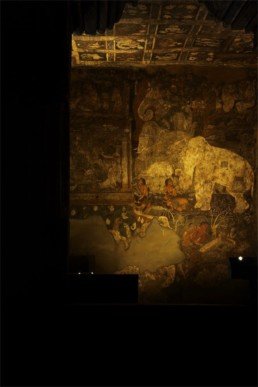
© 2025 prasadpawar. All rights reserved
TEAM WORK
A team was prepared consisting cameramen, ladder assistants, tripod assistants, coordinator, computer operator, cable technician, other operators, radio operator, Temperature meter reader, grey card, focusing card and colour card assistant. A daily schedule was prepared for review of the work done up to the stage and the activities to be planned for next day. After 2 hours we were experiencing the sickness. When we started analyzing that why the sickness is coming every after 2 hours, it is found that in the area of 35m x 28m and of the height of 2m to 3m. There were only three to four Windows and only one door from which the light was entering and having no proper ventilation. When around 2000 to 5000 tourist enter into this the low level of oxygen available in the case was bringing the sickness to us. To overcome this difficulty of every after 2 hours our team is to leave the work-spot and go out of the caves for about 20 minutes to get a fresh air, breathe it and come again with the great enthusiasm into the caves again to work for the next two hours. Every time after two hours we thought that this 20 minute should not be wasted. Therefore, I started working on clear sunlight and started first the photography on the sculptures available in the sunlight and then I found a new subject about the chisel work made on the sculpture. It attracted me and I could understand the sculpture more and more clearly and closely. Then I imagine that how the stone have been shaped and while carving the stone, how the chisel was used, what could be the size and shape of the chisel and how the original caves were made of that time. Which part could have cut first time and to proceed the work of carving the Caves. While doing this chisel work, I could understand lot of things of the creation of these caves of Ajanta.
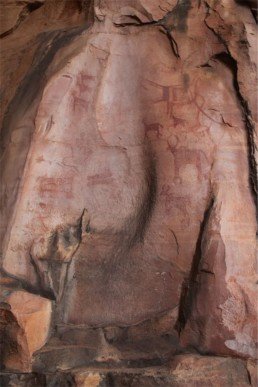
© 2025 prasadpawar. All rights reserved
EXPERIMENTS
Ajanta caves are around 350 km away from my city Nasik. My technical workshop is available in Nasik city. Therefore for any silly small matter I had to travel for 350 km back to Nasik and to avoid this technical accessories which are used for this Ajantha project to make the accessibility and demonstration of these accessories required in Ajanta caves have been experimented in the Pandav leni (Pandavas caves) available near Nasik. The demonstration was being done in Pandavas caves near Nasik and afterwards they are actually used in Ajanta caves. While making a demo at Nasik, all the difficulties which we experienced they have been overcome before going to Ajanta Caves. This trial and error method were used in the demonstration of photography and this was a scientific approach with the best of the accessories and I could get it a great success out of this. My father being a technician, this habit was inculcate in me since my childhood and my mind was set accordingly. Therefore when I had seen any of the difficulty the solution was ready with me. Many of my experiments have failed but from every experiment I could get better and better ways of going to their success. I had two options available either photograph the paintings in its original condition or reference to the paintings, identify the missing portion which later to be corrected and then restore the painting in the modified condition.
AJANTA CAVE CONSTRUCTION, SHAPE, & ILLUMINATION
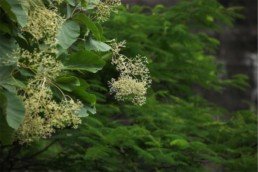
© 2025 prasadpawar. All rights reserved
It could take most of my time to understand the light and shades available for my job. It was varying according to the seasons and the position of the Sun. Ajanta Caves from no.1 to no. 30 are in the shape of half circle and this is being affected by solar system. The orientation of the sunrise was observed that the sun rises behind the cave no.1. It throws light on the front side of cave no. 28. In totality, when I studied this natural light is available for the caves no. 20 to 28 in the morning and in the afternoon the caves 1 to 10 have been illuminated by the sunlight. In that case the direct sunlight available in the caves is very small, so the light available in the front yard of the cables is being used by using the reflector and that reaches in a very small amount inside the caves. Using this reflected light and the light naturally available from windows of the cave has been the accepted condition for the photography in further due course.
SOURCE OF LIGHT
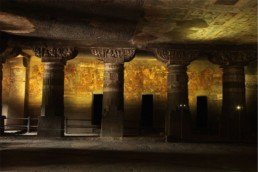
© 2025 prasadpawar. All rights reserved
It is also been experienced while working on the Ajanta that we should have a knowledge of different subjects. These different subjects which are associated with the photography of Ajanta have been a great challenge to do this photography in a very limited source of light. Sometimes it is fully dark and if you go to Ajanta you will find that the light is very very limited. We have to do a photography in a present light situation which is all around 4 lux intensity. There are hardly 1door and 2 to 4 windows and no proper ventilation. Windows are hardly 1m x 1.25 m or 1m x 1m. and they are so small. Even the light available through doors is very limited. Second constraint was the light available from these Windows and doors is different at different days in the year and of different intensity therefore a definite intensity light is not available all the time. In short, the light which is been used through reflectors from outside the caves is the only source available to get the light inside the cave. For example cave no. 1, the size of the cave is 35m x 28m and 2 to 3 m high, so the light coming into this caves is not sufficient. Therefore the desired level of light is not available in the cave. If you really estimate for this kind of such a big area available in the cave the level of 4 to 5 lux. For the photography around 200 to 500 Lux light is ideal condition for reading the pictures but it is only 5 lux. It is not more than 5 Lux light available in the Caves and the light which is coming directly into the cave is not enough. Basically this light falls on the dark black-grey stones and the stones are made of basalt which is very porous so the light falling on this is not being reflected again. It is been absorbed in the stone itself therefore the reflection of the light is very limited within the caves.
AMOUNT OF LIGHT
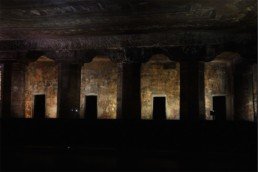
© 2025 prasadpawar. All rights reserved
The caves are made before 2000 years. And the paintings on the walls, roof and pillars have been exposed to the atmosphere for such a long time, which ultimately resulted in formation of carbon layer on the surfaces and it reflects a very small amount of light. In 1970, French scientists have concluded that if we use intensive light on the paintings, the paintings will be damaged because of this and they will be damaged permanently over a period of time and according to this conclusion the Archeological Survey of India has put the Cotton Canvas Light cutters for restricting the light onto the paintings. This arrangement was done where the paintings are already available in caves number 1, 2, 16 and 17. In these 4 caves this sunlight is restricted and not allowed to be inside the caves. But for the tourists, the fibre optical lights have been used which are only of maximum 5 lux and this artificial light is being used and we get the feel. We also understand the meanings by seeing these paintings of Jatak Tales. In fact, If you have any reference of earlier photographs seen about this then only you understand the picture but being the light is very much limited it is very difficult to see the paintings, to read the paintings and recall the paintings in your mind and this process is restricted because of a very limited light. If you really understand this paintings and to see it very clearly, it requires around 200 to 500 lux light and if you look into this with this amount of light available then only you can see every detail of this paintings like the color combination, the shape, the density, the texture, the carving, the poster brush strokes and all this micro work of this paintings.
CREATING THE SURFACE

© 2025 prasadpawar. All rights reserved
The paintings which are created in the history in Ajanta is of around 2000 years old. The natural art of that era is being predicted in these paintings and that has been used while creating the surface. While creating the surface the internal walls have been plastered and then the paintings are created on those plastered walls. The rough surfaces of the stone have been smoothened by using natural fibers like dried tree, grass, fodders etc and has been created with the use of different adhesives and sealants. This surface with a plaster is very hard and thousands of years it is available on the stones. After drying of these plasters on the stones the pictures have been painted on this surfaces. While creation of these paintings, Jatak Tales have been painted with proper construction of stories, sketches and paining of colors etc.
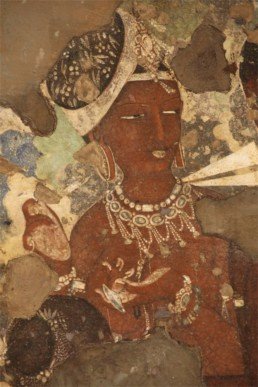
© 2025 prasadpawar. All rights reserved
WALL PAINTING FRESCO
This type of plaster or the wall paintings are called Fresco in Europe, but the pictures which are drawn in Europe on these type of surfaces are drawn when the surface is wet. Therefore the pictures drawn on wet surfaces are easy to restore. The pictures in this method are drawn on a wet plaster where the paint is being soaked into the plaster and therefore it is long lasting so it is easy for Restoration of this pictures. But in Ajanta, the pictures are drawn only after drying up of this plaster therefore this paint are like cream on the milk. These layers of the paint are on dry surface and in the form of powder so it is very difficult to restore all this damaged portions on these pictures. These pictures are getting destroyed day by day. The surface where the pictures are painted in the caves are not glittering surfaces and all natural paints have been used for this purpose. Different kinds of leaves, flowers etc. have been used from the nature to create the paints, as well as the different kinds of stones available from the earth in different colors are used to create the paints. This is what is being concluded. This may be the secret of these paintings that even after 2000 years, these pictures are available for us because of these natural paints which are created from the nature. The paints which are made in today’s era are hardly available for 5 to 7 years even though they are made with the modern technologies but the paints which are made from the natural resources are available for the last 2000 years. From this evidence it is concluded that, at that time there must be a scientific method to create the paints and there must be laboratories to test this kind of paints. After the certification of these paints from those Laboratories they must be used while creating these paintings.

CAMERA & TECHNOLOGY
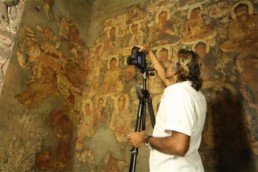
This type of plaster or the wall paintings are called Fresco in Europe, but the pictures which are drawn in Europe on these type of surfaces are drawn when the surface is wet. Therefore the pictures drawn on wet surfaces are easy to restore. The pictures in this method are drawn on a wet plaster where the paint is being soaked into the plaster and therefore it is long lasting so it is easy for Restoration of this pictures. But in Ajanta, the pictures are drawn only after drying up of this plaster therefore this paint are like cream on the milk. These layers of the paint are on dry surface and in the form of powder so it is very difficult to restore all this damaged portions on these pictures. These pictures are getting destroyed day by day. The surface where the pictures are painted in the caves are not glittering surfaces and all natural paints have been used for this purpose. Different kinds of leaves, flowers etc. have been used from the nature to create the paints, as well as the different kinds of stones available from the earth in different colors are used to create the paints. This is what is being concluded. This may be the secret of these paintings that even after 2000 years, these pictures are available for us because of these natural paints which are created from the nature. The paints which are made in today’s era are hardly available for 5 to 7 years even though they are made with the modern technologies but the paints which are made from the natural resources are available for the last 2000 years. From this evidence it is concluded that, at that time there must be a scientific method to create the paints and there must be laboratories to test this kind of paints. After the certification of these paints from those Laboratories they must be used while creating these paintings.
© 2025 prasadpawar. All rights reserved
LAUNCH OF PHOTOGRAPHY
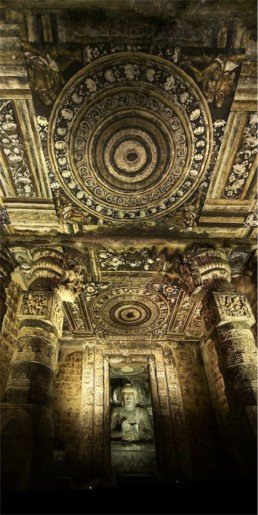
© 2025 prasadpawar. All rights reserved
The paintings which are created in the history in Ajanta is of around 2000 years old. The natural art of that era is being predicted in these paintings and that has been used while creating the surface. While creating the surface the internal walls have been plastered and then the paintings are created on those plastered walls. The rough surfaces of the stone have been smoothened by using natural fibers like dried tree, grass, fodders etc and has been created with the use of different adhesives and sealants. This surface with a plaster is very hard and thousands of years it is available on the stones. After drying of these plasters on the stones the pictures have been painted on this surfaces. While creation of these paintings, Jatak Tales have been painted with proper construction of stories, sketches and paining of colors etc.
CHALLENGES

© 2025 prasadpawar. All rights reserved
The caves are made before 2000 years. And the paintings on the walls, roof and pillars have been exposed to the atmosphere for such a long time, which ultimately resulted in formation of carbon layer on the surfaces and it reflects a very small amount of light. In 1970, French scientists have concluded that if we use intensive light on the paintings, the paintings will be damaged because of this and they will be damaged permanently over a period of time and according to this conclusion the Archeological Survey of India has put the Cotton Canvas Light cutters for restricting the light onto the paintings. This arrangement was done where the paintings are already available in caves number 1, 2, 16 and 17. In these 4 caves this sunlight is restricted and not allowed to be inside the caves. But for the tourists, the fibre optical lights have been used which are only of maximum 5 lux and this artificial light is being used and we get the feel. We also understand the meanings by seeing these paintings of Jatak Tales. In fact, If you have any reference of earlier photographs seen about this then only you understand the picture but being the light is very much limited it is very difficult to see the paintings, to read the paintings and recall the paintings in your mind and this process is restricted because of a very limited light. If you really understand this paintings and to see it very clearly, it requires around 200 to 500 lux light and if you look into this with this amount of light available then only you can see every detail of this paintings like the color combination, the shape, the density, the texture, the carving, the poster brush strokes and all this micro work of this paintings.
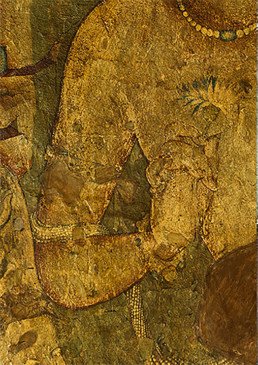
© 2025 prasadpawar. All rights reserved
A BIG HALT & BACK TO RESEARCH
This type of plaster or the wall paintings are called Fresco in Europe, but the pictures which are drawn in Europe on these type of surfaces are drawn when the surface is wet. Therefore the pictures drawn on wet surfaces are easy to restore. The pictures in this method are drawn on a wet plaster where the paint is being soaked into the plaster and therefore it is long lasting so it is easy for Restoration of this pictures. But in Ajanta, the pictures are drawn only after drying up of this plaster therefore this paint are like cream on the milk. These layers of the paint are on dry surface and in the form of powder so it is very difficult to restore all this damaged portions on these pictures. These pictures are getting destroyed day by day. The surface where the pictures are painted in the caves are not glittering surfaces and all natural paints have been used for this purpose. Different kinds of leaves, flowers etc. have been used from the nature to create the paints, as well as the different kinds of stones available from the earth in different colors are used to create the paints. This is what is being concluded. This may be the secret of these paintings that even after 2000 years, these pictures are available for us because of these natural paints which are created from the nature. The paints which are made in today’s era are hardly available for 5 to 7 years even though they are made with the modern technologies but the paints which are made from the natural resources are available for the last 2000 years. From this evidence it is concluded that, at that time there must be a scientific method to create the paints and there must be laboratories to test this kind of paints. After the certification of these paints from those Laboratories they must be used while creating these paintings.
ON ASSIGNMENT
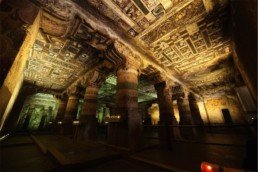
© 2025 prasadpawar. All rights reserved
With this ambition in mind new process of photography started with emphasize on temperature of color. The level of illumination, light required and it’s appropriate temperature was thought of, because during photography light is vital important factor and if the light is off clear and clean sun rays and if its intensity is very correct then the work on photography is very effective and convenient but in Ajanta right temperature of the light is very difficult to obtain. Because direct sunlight is not entering into the caves and the light which enters through windows being reflected from some of the surfaces and during this reflection it is being carrying the basic color of the surface for example if light falls on red color reflection of this light carries a red shade into its original light, therefore the natural light which enters into the caves through windows and its reflection from the surfaces in the caves it is polluted in the form of temperature of its original color and in this temperature if this normal condition is followed for photography this brings lot of variations into the original colors of the painting. Therefore the light coming out from the windows and the artificial light made available the combination of both the slides scientifically analyzed and from this experiment the photography was found to be more closer to the originality and then ultimately the journey of Ajanta photography started.
AFTER 200 YEARS
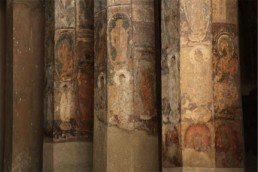
© 2025 prasadpawar. All rights reserved
Ajanta Caves were found on 28th of April 1819 by a British officer John Smith, who was on the mission of his hunting and he found this Ajanta Caves. After 200 years it was found that these caves were used by human for cooking food and for taking Honey from the honeycomb and during that time they used to make lot of smoke. Because of the smoke there is lot of deterioration in the paintings. Before restriction of the Archeological Survey of India many of the tourist have also damage the paintings intentionally. Therefore many of the paintings have been now protected with a glass frames. It is very difficult task to document all this from the Ajanta on the verge of its diminishing time. Our research needs to identify what portion of paintings has been damaged. Many of these paintings they are either too dark or more light inside or somewhere it is colorless, some where it is only in the form of lines. Considering all these nature of defects each and every micro portion of the field of the paintings have been taken up for color correction and these have been restored into the computers where the color temperature is again corrected to the normal paintings and this variation is controlled very well.
27
MONUMENTS
PHOTOGRAPHY DOCUMENTATION
05
LANGUAGES
SEARCHING REFERENCE IN TEXT & LANGUAGES
54
TECHNO BRANDS
WORLD CLASS TECHNOLOGY, OFFICIAL SOFTWARE USED
55,000

